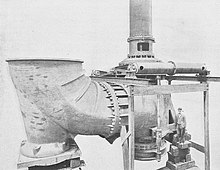Paul Piccard
Paul Piccard (born May 9, 1844 in Lutry , Canton of Vaud , † October 17, 1929 in Lausanne ) was a Swiss engineer and brother of Jules Piccard .
After Paul Piccard had studied at the Polytechnic in Zurich from 1862 to 1866 , he worked for the metal construction company Ott & Cie in 1866 and 1867 . in Bern , which later built the Kirchenfeld Bridge , among other things . In 1867 he traveled on behalf of the Geneva stove manufacturer Weibel, Briquet & Cie. to Paris , where the world exhibition took place in 1867 and he sold hot air ovens according to the Staib system.
From 1869 to 1881 Piccard was professor of mechanics at the École d'ingénieurs de Lausanne . During this time he also invented the Piccard apparatus or Weibel-Piccard evaporation apparatus used in salt production . Jules Weibel was the owner of Weibel, Briquet & Cie. who built the plants. Such was successfully used in the Bex salt mine . The method uses the thermal compression and enables in relation to the evaporation of the brine in a Salzsiedepfanne substantial savings in fuel. The process was not invented by Piccard, but he led the scraper (English "scratches".) A - a device with which during operation the fouling on the heat exchanger could be removed.
In 1872 Piccard gave up his academic position and after the death of Jules Weibel took over the company Weibel, Briquet & Cie. Together with Jules Faesch . The company was renamed Faesch & Piccard and the manufacture of heaters was transferred to Audéoud & Cie. sold. Piccard built the Faesch-Piccard turbine in 1886, which was able to convert the energy of the pressurized water network in Geneva into a rotating movement to drive machine tools . The special thing about the turbine was the load regulator developed by Piccard, which kept the speed of the turbine constant regardless of the load. The winning of the competition to supply the turbines for the Edward Dean Adams Power Plant can be regarded as the greatest success of Faesch & Piccard. The facility built at Niagara Falls in North America was the world's first large power plant. The 5000 hp turbine wheels were manufactured in America because of import duties, but their governors were supplied from Switzerland.
After Faesch's death in 1895, he teamed up with Lucien Pictet (1864–1928), the son of the Geneva banker Ernest Pictet. The company became the Ateliers Piccard-Pictet & Cie. , which from 1906 produced the Auto Pic-Pic as well as turbines . During the First World War , they made ammunition for the Entente . With the capital generated during the war, the company was greatly expanded with the aim of setting up industrial production of luxury cars. The valve motor intended for the car , however, was unsuitable for series production at the time because very small dimensional tolerances would have had to be adhered to. As a result, delivery deadlines could not be met, and the cars became unreliable, so customers dropped out and the company went bankrupt in 1920. The banks took over the bankruptcy estate and founded the Ateliers des Charmilles SA from it in 1921 .
literature
- Peter Müller-Grieshaber: Piccard, Paul. In: Historical Lexicon of Switzerland .
Web links
- International Genevan business in the long run: from the greats fairs to the second industrial revolution. European Business History Association , accessed May 16, 2015 .
- G. Lung: Notes from the Paris World's Fair. In: Journal for Applied Chemistry. 2, 1889, pp. 569–571, doi : 10.1002 / anie.18890022002 (to the evaporator)
Individual evidence
- ^ A. van Muyden: Les turbines Faesch et Piccard à Niagarafalls . In: Bulletin de la Société vaudoise des ingénieurs et des architectes . Volume 21, No. 8 , 1895, p. 247-249 , doi : 10.5169 / seals-18769 .
- ↑ Thomas Gull: Five Things We Should Know About World War I. University of Zurich, September 2, 2014 .
| personal data | |
|---|---|
| SURNAME | Piccard, Paul |
| BRIEF DESCRIPTION | Swiss mechanical engineer |
| DATE OF BIRTH | May 9, 1844 |
| PLACE OF BIRTH | Lutry , Canton of Vaud |
| DATE OF DEATH | October 17, 1929 |
| Place of death | Lausanne |

